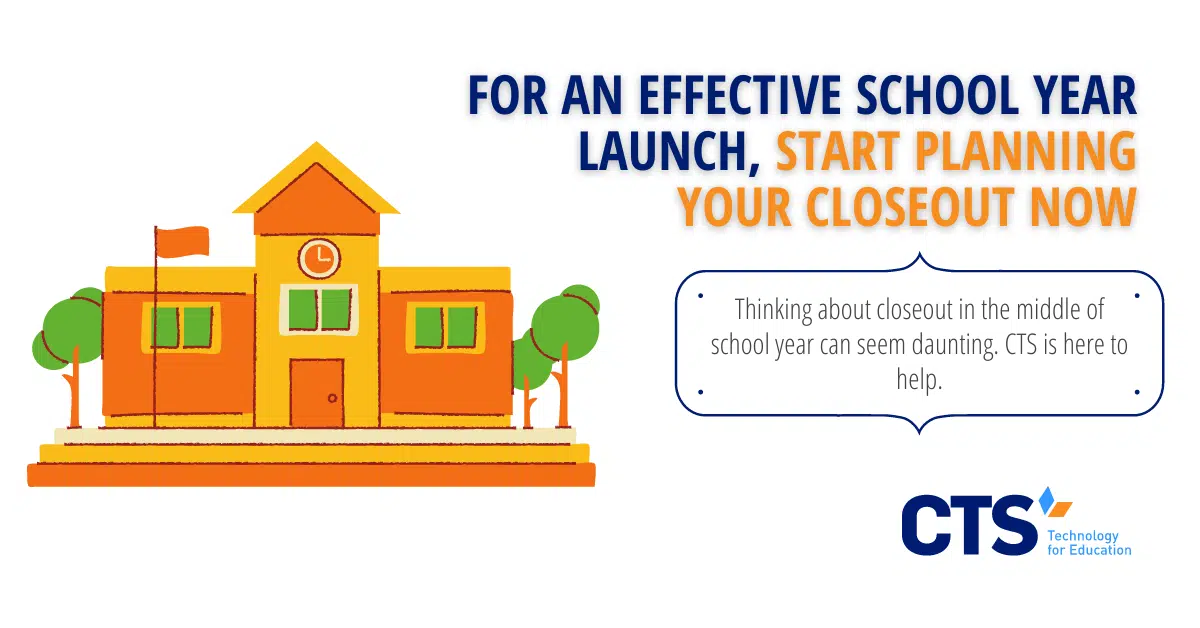It can be hard to plan ahead in the middle of a busy school year.
With state testing, parent-teacher conferences, and other high-priority academic tasks to complete, thinking about a school year closeout in March or April is near the bottom of many school leaders’ to-do lists. Planning an effective closeout takes time, sustained attention, and feedback from other school stakeholders, many of whom are stretched thin as the end of the year approaches.
Failing to conduct an effective school closeout can, however, compromise the next school year’s launch: if technology isn’t returned, rooms aren’t cleaned out, or staff IDs aren’t turned in, the school’s non-instructional team members will spend precious time and energy addressing such issues at the start of the following year.
Similarly, closeout presents the last, best opportunity for school leaders to gather critical information from students and families about their next-year plans before departing for summer vacation. By leveraging closeout to determine which students will return, which are moving, and undecided, school leaders can more accurately forecast their next-year enrollment, staffing needs, and budgets.
Conducting an effective school year closeout is especially important in the educational technology space. Below, we outline a few ways school leaders can leverage school closeout to improve their technology programming and set their schools up for success as the start of the next school year approaches.
Make a plan to collect and tag all of your school’s student and staff devices.
It might sound simple, but collecting and tagging all of your school’s student and staff devices is the first step in getting a handle on your school’s technology inventory. School closeout gives school leaders their last, best chance to collect their school’s Chromebooks, laptops, and other school-issued hardware before students and teachers depart for summer vacation.
To facilitate the return of the school’s technology, school leaders should start to communicate their plan early. In late March or April, tell students’ families that their laptops, wireless hotspots, and other school-issued technology will need to be returned to the school by a particular date. School leaders might also consider creating an individual checklist for each student to track their closeout “progress.” The checklist might include returning the school’s technology and filling out an “intent to return” form, among other items, for example. The same goes for teachers and staff members. By messaging technology-return procedures early—preferably during a school-wide meeting, rather than over email—school leaders can make sure all of their team members are on the same page before the last day of school.
Of course, even if the school allows students and staff members to take certain devices home for the summer, they should still create a plan to tag and inspect the devices if they haven’t already done so. Again, the end of the year is the last time school leaders will have their students and staff members all in one place, so it’s important to use such time wisely.
Decide which devices need repair and which need replacing.
After they’ve tagged and inventoried their school’s devices, school leaders can then determine which need repair or replacement. Putting each device’s make, model, tag, and status (i.e., “working,” “needs repair,” etc.) into a shared spreadsheet, gives school leaders a bird’s-eye view of their school’s technology inventory.
Systematically cataloging the school’s inventory eliminates the guesswork that often comes with next-year technology ordering. If a school leader can pinpoint with exact accuracy the number of Chromebooks she expects she’ll need for the following year, she can save hundreds of dollars she might otherwise spend on additional devices the school doesn’t actually require. With those savings in hand, she can devote scarce financial resources to other instructional priorities like a new classroom library, curriculum kit, or professional development resources.
Therefore, conducting an effective school closeout can generate positive, “downstream” effects beyond educational technology or other non-instructional domains. An efficient close-out allows the school to get organized before the end of the year and empowers school leaders to make more sound financial decisions that will impact other areas of school programming.
At CTS, we help schools accomplish their unique missions.
Our team has worked with more than 60 schools across the United States to improve their technology programming and accomplish their unique missions. We view ourselves as deeply ingrained in the work of our partner schools and know that planning for a school year closeout in the middle of March or April can seem daunting. That’s why our team is here to help. By sharing best practices and supporting school leaders in conducting an effective closeout, we know that the school will have a stronger next-year launch that positively impacts teachers, students, and families. Contact us today to learn more about our services and how we can help your school accomplish its unique mission.




